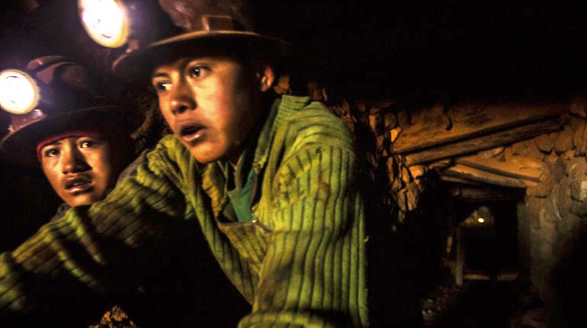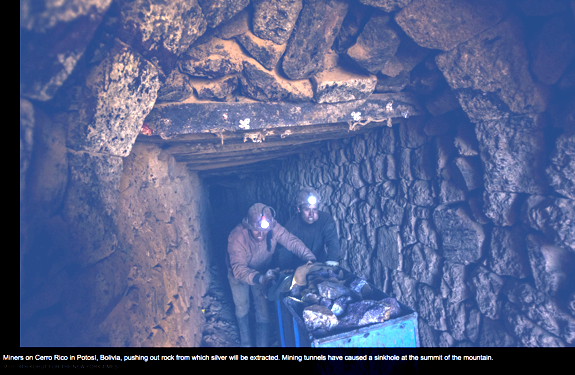 Video (above) [Click picture to go to original article; run video from there]
Video (above) [Click picture to go to original article; run video from there]
Facing Death in the Search for Silver Centuries of mining have left a sinkhole at the summit of Bolivia's famed Cerro Rico. Miners fear a collapse but also worry that the government will shut down the mine.
For Miners, Increasing Risk on a Mountain at the Heart of Bolivia's Identity
September 16, 2014 - New York Times
By WILLIAM NEUMAN
POTOSÍ, Bolivia — The silver in this mountain helped finance the Spanish empire. It created vast fortunes for some and misery for many more. It fueled the early growth of European capitalism, setting the stage for the modern era.
But now, after centuries of hauling out its riches, miners working near the peak have clawed away so much of the interior of the mountain that it is caving in from the top down.
At the peak of this historic mountain — known as Cerro Rico, or Rich Hill, standing at more than 15,600 feet — a giant sinkhole has opened, a jagged mouth in the blood-red rock.
In June, Unesco warned that the mountain, depicted at the center of Bolivia's flag, faced a critical risk of collapse at its summit.

"Since the internal structure of the upper part of the Cerro Rico is severely weakened due to continuous exploitation," it said, "there is a significant risk that miners could die from collapses inside the tunnels."
In July, the government said that it planned to shut down mines above 14,435 feet, where about 1,500 miners work in conditions that can range from rudimentary to brutal. Many thousands of miners work in mines farther down the mountain.
"It is an emergency where we have to act quickly," said Marcelino Quispe, the president of the government-run Bolivian Mining Corporation, known as Comibol. It grants concessions to the private companies known as cooperatives that work on the mountain, and it helped pay for a failed effort last year to stabilize and cap the sinkhole.
But many miners do not want to leave, saying that the government has offered to move them to new mines far away, with no guarantee that the sites will be as lucrative as the ones they are leaving.

The miners have developed strong ties to the mines. Some believe that each mine has a god or a spirit, called a Tío, that protects them. The miners give the Tío, usually represented in the mine by a clay figure in the shape of a man, offerings of cigarettes and alcohol, coca leaves and other items.
On a recent day at the Milagro Mine, which is among those the government plans to close, miners shrugged off the suggestion that they could be at risk, saying that their mine was far enough from the area of the collapse at the peak to avoid any danger.
"What worries us is leaving here, going far away, leaving our families behind," said Gregorio Alave, 45. "We will have to fight with the government to get a good mine."
Mr. Alave has an ownership stake in the cooperative that owns the mining concession, but he employs a younger man to do much of the heavier work. A doctor recently told him that he had advanced silicosis, an incurable lung disease common to miners who breathe in rock dust, and that he should stop working underground. But he said that he must keep working to support his family, despite the bad cough he has developed.
Inside the mine, lit only by the battery-powered lamps on miners' helmets, the smell of dynamite hung in the chill air. Miners used shovels to load rock into carts with rubber tires, which they pushed to the surface along a narrow tunnel, ducking down in sections where the ceiling dropped as low as four feet high.
Deep inside, on a small ledge, sat the Tío, with a tiny bottle of alcohol and a pile of coca leaves, like the ones many miners chew as a stimulant to propel them through a day of hard work at high altitude. Throughout the mine were small brightly colored flags and paper ribbons left from a recent festival, which the miners call the Tío's birthday.
The collapse at the top of the mountain started in 2010. Gradually, the sinkhole grew larger, appearing as a bite carved out of what had been the triangular peak of the Cerro Rico. That caused alarm among Potosinos who worried that the icon of their city was damaged.
"It's like the Statue of Liberty for you," said Joel Vera, 40, a computer technician. "Everyone recognizes New York for the Statue of Liberty. Everyone recognizes Potosí for its mountain."
The Cerro Rico is intimately tied to the history of Potosí and Bolivia. Many Bolivians see it as a potent national symbol. Historians say that indigenous groups like the Inca mined the mountain for silver, but intensive mining began in 1545 after the Spanish conquest.
Potosí, a World Heritage site, is considered one of the richest silver deposits ever mined. In combination with silver from other mines in the Americas, it helped change the global economy, vastly increasing the amount of silver in circulation worldwide and creating the conditions for a money-based economy in Europe.
According to the historian Jack Weatherford, "Potosí was the first city of capitalism, for it supplied the primary ingredient of capitalism: money."
Despite its high altitude (about 13,353 feet above sea level), Potosí became one of the world's largest and wealthiest cities in the 16th and 17th centuries. The city center is still full of colonial buildings, such as the mint where the Spanish created silver bars and coins.
It is a mining town to its core. Neighborhood stores sell mining helmets, shovels and dynamite, along with soft drinks and soap. In one shop, a glass case on the counter held a neat stack of dozens of sticks of dynamite.
For all the wealth the mountain generated, the misery outpaced it a hundredfold. The Spanish used Indians, or slaves brought from Africa, to work in the mines in brutal conditions. The death toll was high.
Nonetheless, it may be the mountain's recent history that doomed it. For many years, Comibol mined the mountain. But silver prices plummeted in the 1980s and Comibol pulled out, handing the mountain over to the small private mining cooperatives.
Despite the name, the cooperatives are often owned or controlled by families or small groups, and the majority of miners laboring on the Cerro Rico are employees, with no ownership stake in the companies. The workers often include children, generally in their mid to late teens.
The national ombudsman's office said in a recent report that it had identified 145 children working in mines on the Cerro Rico, most of them 15 to 17.
Mining cooperatives here and elsewhere in Bolivia have tremendous political power, and they tend to operate with little effective oversight. The result, critics say, has been deteriorating conditions in the Cerro Rico for miners and the mountain.
René Vacaflores, 66, a mining engineer who has worked on the Cerro Rico for decades, called the mountain an anthill, saying that it is crisscrossed with tunnels and vertical shafts called chimneys that have proliferated in the years since the cooperatives took over, with little or no regulatory supervision. He said that mining companies no longer kept accurate maps of their tunnels and that in some mines, basic safety measures were crude or absent. He said that in some mines, workers were lowered on ropes down vertical shafts.
"It is hell," Mr. Vacaflores said.
Mr. Vacaflores said that the collapse at the top was partly because of miners pulling rock from vertical shafts that had been filled in after previous periods of mining.
"If the government had run the mountain rationally, with technicians, this wouldn't have happened," he said. "People have gotten rich. They have plundered and plundered."
He said that accidents were frequent and often fatal and that the bodies of dead miners, frequently migrants from the countryside, were often taken straight to their villages for burial so the deaths did not come to the attention of local officials or mining regulators.
Mr. Quispe, the Comibol president, said that his company did not keep track of deaths in the mines, which he said was the responsibility of the individual cooperatives.
"When there is a bigger collapse here, more than 1,000 could die," Mr. Vacaflores said. "These people don't understand that could happen."